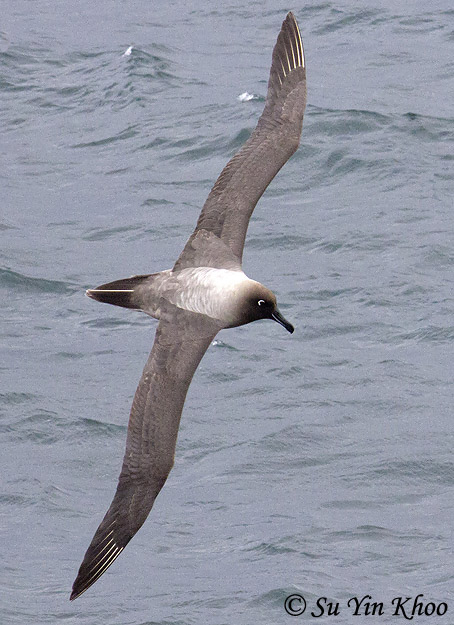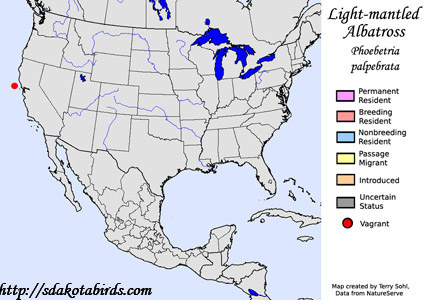| Length: 32 inches | Wingspan: 80 inches | Seasonality: Non-resident in South Dakota |
| ID Keys: Sooty-gray color overall, darker head, lighter back from nape to mid-back, white crescent around eye | ||
 The
Light-mantled Albatross (also known as the Light-mantled Sooty Albatross) is
a beautifully plumaged, small albatross from the southern oceans. They breed
on sub-arctic islands in multiple locations across the Atlantic, Pacific,
and Indian Oceans. Outside of breeding, individual birds range widely
across the southern oceans, but typically remain over cold waters, from
about 35 degrees south latitude all the way to the edge of the Antarctic
pack ice. The lone record from North America was a sighting off the
coast of California in 1994, a completely unexpected occurrence given that
the species rarely wanders far from the cold southern oceans.
The
Light-mantled Albatross (also known as the Light-mantled Sooty Albatross) is
a beautifully plumaged, small albatross from the southern oceans. They breed
on sub-arctic islands in multiple locations across the Atlantic, Pacific,
and Indian Oceans. Outside of breeding, individual birds range widely
across the southern oceans, but typically remain over cold waters, from
about 35 degrees south latitude all the way to the edge of the Antarctic
pack ice. The lone record from North America was a sighting off the
coast of California in 1994, a completely unexpected occurrence given that
the species rarely wanders far from the cold southern oceans.
As with many other Albatross species, they are considered an at-risk species. Long-line fishing takes a toll on birds that are accidently caught (and drowned) as bycatch. Predators such as rats and cats that have been accidentally introduced to their breeding islands also negatively impact populations as breeding success is greatly reduced.
Habitat: Found on a number of islands in the far southern oceans when breeding, including islands off the coast of southern Australia and New Zealand, South America, and South Africa. Nesting areas are typically rocky cliffs or other steep slopes. Non-breeding birds are found throughout the southern oceans, typically far out at sea, from the edge of the Antarctic pack ice to 35-degrees south latitude.
Diet: Feeds on fish, squid, krill, and sometimes carrion.
Behavior: Feeds by swimming on the ocean's surface and reaching down to grab food items. Will also make shallow dives under the water in pursuit of prey.
Nesting: Breeding is usually done in loose colonies. The nest is a mound of moss, mud, and grasses. A single egg is laid, and both the parents help incubate it during a long incubation period of just over 2 months. Both parents help to raise and feed the young after hatching, and sometimes both parents are out foraging while the chick remains alone in the nest. Nesting pairs are faithful and may return to the same nest site to breed together for years, renewing their bonds each season upon returning to the breeding site. Nesting occurs every 2 years.
Song: Has a harsh, trumpet-like call, most often heard around breeding colonies.
Migration: Breeds on a number of sub-arctic islands in the far southern Indian Ocean, Atlantic Ocean, and Pacific Ocean near New Zealand. After leaving the breeding grounds, they may found nearly anywhere in the cold southern oceans.
Interactive eBird Map: Click here to access an interactive eBird map of Light-mantled Albatross sightings
Similar Species: Most likely to be confused with the Sooty Albatross.
Conservation Status: The effects of longline fishing bycatch, as well as introduced predators on their breeding islands, has led to the IUCN listing the Light-mantled Albatross as "Near Threatened".
Further Information: 1) Ocean Wanderers.com - Light-mantled Albatross
2) BirdLife International - Light-mantled Albatross
3) Australian Government Species Page - Light-mantled Albatross
Photo Information: Photo taken by Su Yin Khoo - South Pacific ocean - Photo licensed under Creative Commons Attribution-NonCommercial-ShareAlike 2.0 Generic License.
| Click below for a higher-resolution map |
 |
| South Dakota Status: Non-resident in South Dakota. Only one record in North America. |
Additional Light-mantled Albatross Photos (coming soon!!)
